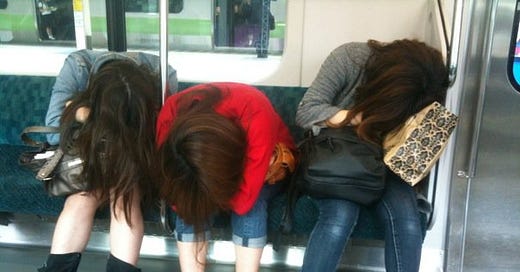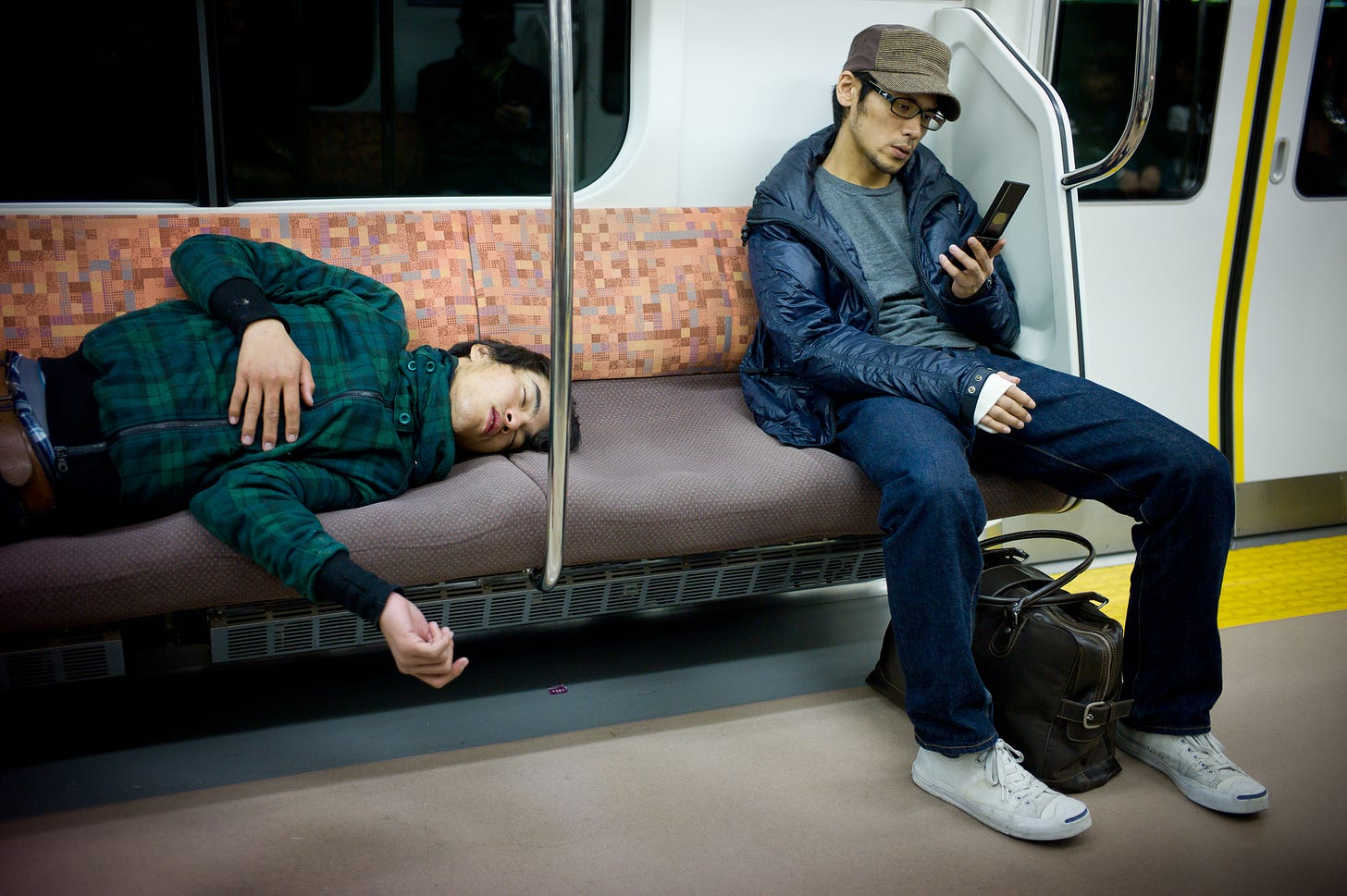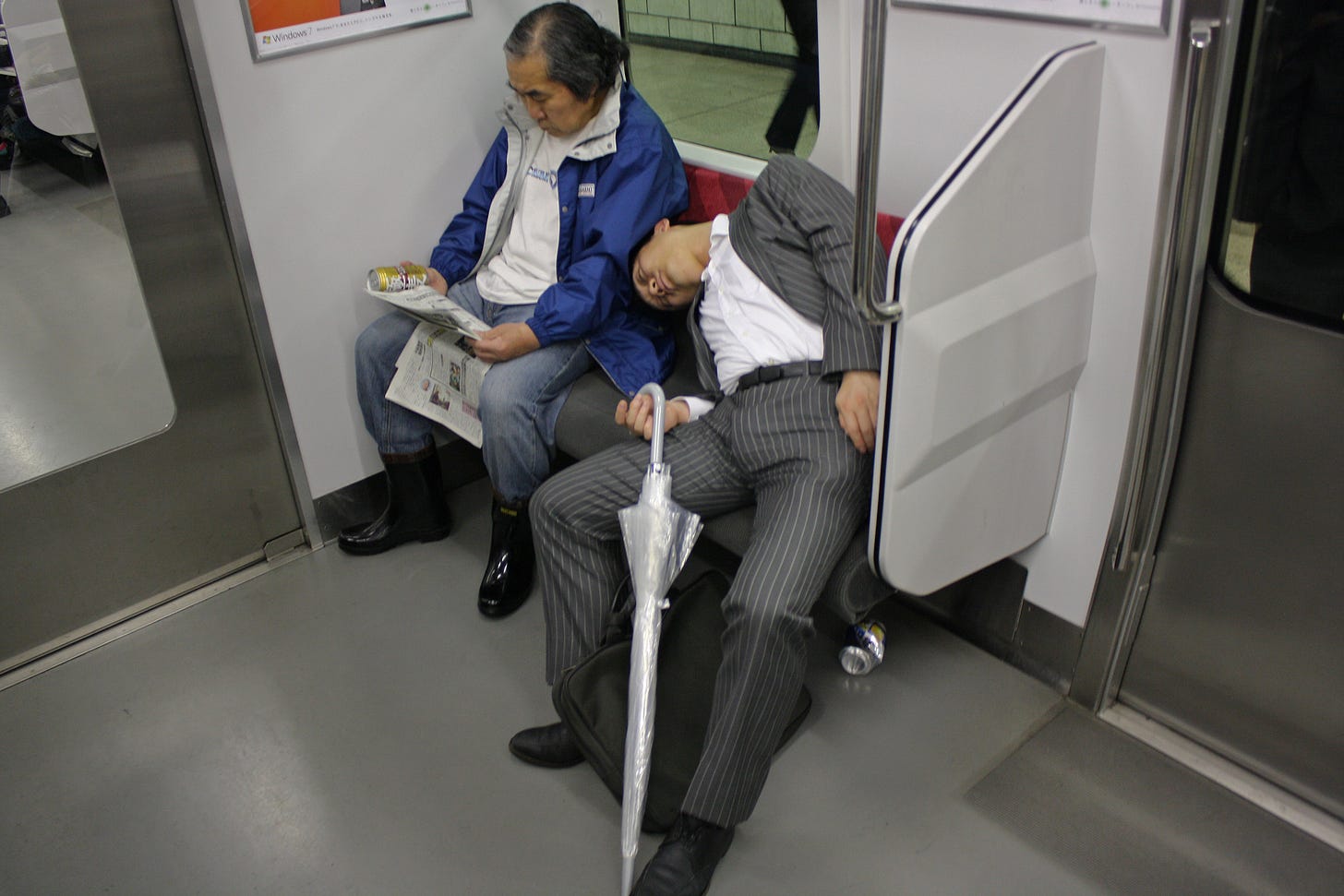Although the current series focuses on the Yamanote Line, the following advice is valid on any local train in Japan.
Don’t forget the special 80% discount on annual paid subscriptions.
$30 → $6 (see link above)
Here’s a chance to support Tokyo Calling for cheap.
In the latest post I wrote that the Japanese usually go to great lengths not to bother the people around them, and this is even truer in closed spaces, like on a train.
However, this does not mean that the Japanese are blameless train riders or that people don’t get frustrated with their fellow passengers’ behavior.
The Japan Private Railway Association conducted an online survey on public manners at train stations and on trains. The survey was held over a two-month period, from Sunday, October 1 to Thursday, November 30, 2023, and received responses from 8,210 participants.
Below is the ranking of the most commonly cited nuisances, with comparisons to the previous year. In order:
Current rank, [Previous rank], Problem, Percentage, [Previous percentage].
1 [1] Sprawling or poor sitting posture (e.g. spreading legs) 37.1% (34.3%)
2 [5] Coughing or sneezing without covering 33.5% (22.3%)
3 [3] Poor manners when boarding or alighting (e.g. blocking the door) 31.3% (27.0%)
4 [2] Loud conversations, running around 30.3% (33.9%)
5 [4] Improper handling of luggage (e.g. bags, umbrellas) 22.8% (24.0%)
6 [6] Inappropriate smartphone use (e.g. while walking, during crowded times) 18.2% (18.7%)
7 [–] Strong smells (e.g. perfume, detergent, cosmetics) 17.0% (–)
8 [6] Leaving trash behind (e.g. bottles, wrappers) 15.6% (18.7%)
9 [8] Riding while intoxicated 14.0% (15.9%)
10 [9] Improper use of priority seats 10.9% (14.4%)
11 [10] Sound leakage from headphones/earphones 10.0% (13.7%)
12 [14] Sitting on the train floor 8.3% (8.8%)
13 [11] Other complaints 7.7% (10.7%)
14 [15] Eating or drinking on a crowded train 7.1% (8.0%)
15 [12] Misuse of escalators and elevators 6.9% (10.3%)
16 [13] Applying makeup on the train 6.8% (10.2%)
17 [16] Use of electronic devices (e.g. laptops, handheld games) 3.0% (4.0%)
18 [17] Transporting pets 1.3% (2.1%)
19 [18] No particular annoyance noted 0.7% (0.6%)
This time around, the new entry was "Strong scents (perfume, detergent, fabric softener, cosmetics, etc.)," that debuted in 7th place.
I find it surprising that it wasn’t included in previous surveys because the Japanese are very sensitive to smells - unless it’s alcohol.
Going deeper, here are more detailed examples of problems ranked #1, 3, 5, and 6.
① Most Annoying "Seating Manners"
Not sitting close together (e.g. leaving space, placing bags on seats)43.3%
Stretching or crossing legs while seated 22.3%
Bumping into others with luggage or body (e.g. large bags, elbows, crossed arms)17.4%
Not offering seats to the elderly, disabled, pregnant women, etc. 7.6%
Children standing on seats with shoes on 4.2%
② Most Annoying "Boarding and Alighting Manners"
Standing near the door and blocking others (e.g. not moving inside) 62.4%
Boarding without waiting for others to exit 18.5%
Cutting in line to board 6.2%
Running onto the train 4.5%
Pushing other passengers 3.7%
③ Most Annoying Behaviors in "Handling Luggage and Belongings"
Wearing backpacks or shoulder bags without removing them 46.4%
Mishandling umbrellas (e.g. wet, pointing tips at others) 19.6%
Placing belongings on seats 13.3%
Leaving items on the floor (by feet) 6.1%
Handling carry-on suitcases poorly 3.6%
Leaving items near the doors 1.8%
④ Most Annoying Behaviors in "Smartphone Use"
Using a smartphone while walking 45.9%
Using a smartphone in a crowded train 24.6%
Using a smartphone while boarding or exiting 13.8%
Ringing phones or phone conversations 5.9%
In response to the question, “Do you think manners at stations and on trains have improved compared to the past?” the most common answer was “No change”, selected by 43.2% of respondents.
Compared to the previous year, the percentage of people who answered “Improved” or “Slightly improved” declined, while those who responded “Slightly worse” or “Worse” increased, indicating a growing sense that public transportation etiquette may be deteriorating - or that people are becoming for sensitive and less forgiving.
To end this post on a positive note, below are some specific examples shared by passengers when asked about experiences that made them feel “happy” while using trains and stations.
Seeing someone give up their seat to a person in need
A fellow passenger helping someone with a stroller get on or off the train
Someone assisting a person who felt unwell on the platform
A kind word or thoughtful announcement from a station staff member or conductor
A conductor waving to a child after the parent and child exited the train
A person offering an elevator to someone carrying heavy luggage
A regularly used station being beautifully renovated
A nearby passenger noticing and returning a lost item
These small but meaningful actions left a lasting positive impression on many passengers.
Now it’s your turn. As a train or subway user, what drives you up the wall?







Now, you have created a dock to unload trucks of frustration (:
My pet hate is sniffling; it is a national sport. Also, people staying at the entrance upon entering the train with plenty of space inside. The first I try to ignore or wear headphones, for the second I PUSH because there are people behind me who also push.
My kryptonite is having a heavy smoker who clearly doesn’t have an interest in regular laundry washing, or personal grooming, and spends their evenings sitting in izakayas or pachinko parlors. It’s one of the few times I’ll actually get up and sit somewhere else. I’ll take the heavy perfume any day of the week over that.